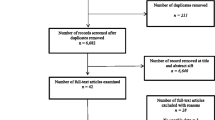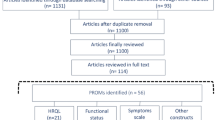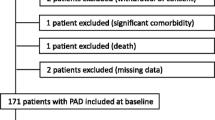Abstract
Objectives
The aim of this study was to identify domains that determine quality of life in patients with peripheral arterial disease and find the patient-reported outcome measures that can examine the identified themes.
Methods
A systematic review of all the main six databases was undertaken to identify primary qualitative studies reporting on the health and/or quality of life of patients with peripheral arterial disease. The quality of studies was assessed using the Critical Appraisal Skills Program criteria. Findings from the included studies were analysed using framework analysis methodology. The identified themes were mapped against the items/domains of validated patient-reported outcome measures used in patients with peripheral arterial disease.
Results
The systematic review identified eight papers that fulfilled the inclusion criteria. The included papers reported the views of 186 patients with peripheral arterial disease including patients with intermittent claudication, critical ischaemia and amputation secondary to peripheral arterial disease. The overall quality of the included studies was good based on Critical Appraisal Skills Program criteria. Framework analysis identified 35 themes that were divided into six main groups: symptoms, impact on physical functioning, impact on social functioning, psychological impact, financial impact and process of care. The best-fit generic and disease-specific patient-reported outcome measures were the Nottingham Health Profile and the Vascular Quality of Life Questionnaire, respectively. None of the patient-reported outcome measures covered all the themes important to patients with peripheral arterial disease.
Discussion
The findings from the review identified the important domains that affect patients living with peripheral arterial disease. None of the current generic and disease-specific patient-reported outcome measures provide a comprehensive measure for all themes that impact the daily living of patients with peripheral arterial disease.

Similar content being viewed by others
References
Fowkes FG, Housley E, Cawood EH, Macintyre CC, Ruckley CV, Prescott RJ. Edinburgh Artery Study: prevalence of asymptomatic and symptomatic peripheral arterial disease in the general population. Int J Epidemiol. 1991;20(2):384–92.
Kannel WB, Skinner JJ Jr, Schwartz MJ, Shurtleff D. Intermittent claudication: incidence in the Framingham Study. Circulation. 1970;41(5):875–83.
American Diabetes Association. Peripheral arterial disease in people with diabetes. Diabetes Care. 2003;26(12):3333–41.
Leng GC, Lee A, Fowkes FG, Whiteman M, Dunbar J, Housley E, et al. Incidence, natural history and cardiovascular events in symptomatic and asymptomatic peripheral arterial disease in the general population. Int J Epidemiol. 1996;25(6):1172–81.
Hirsch AT, Haskal ZJ, Hertzer NR, Bakal CW, Creager MA, Halperin JL, et al. ACC/AHA 2005 Practice Guidelines for the management of patients with peripheral arterial disease (lower extremity, renal, mesenteric, and abdominal aortic): a collaborative report from the American Association for Vascular Surgery/Society for Vascular Surgery, Society for Cardiovascular Angiography and Interventions, Society for Vascular Medicine and Biology, Society of Interventional Radiology, and the ACC/AHA Task Force on Practice Guidelines (Writing Committee to Develop Guidelines for the Management of Patients With Peripheral Arterial Disease): endorsed by the American Association of Cardiovascular and Pulmonary Rehabilitation; National Heart, Lung, and Blood Institute; Society for Vascular Nursing; TransAtlantic Inter-Society Consensus; and Vascular Disease Foundation. Circulation. 2006;113(11):e454–63.
Park KB, Do YS, Kim DI, Kim DK, Kim YW, Shin SW, et al. The TransAtlantic InterSociety Consensus (TASC) classification system in iliac arterial stent placement: long-term patency and clinical limitations. J Vasc Interv Radiol. 2007;18(2):193–201.
Department of Health. Liberating the NHS: transparency in outcomes: a framework for the NHS. 2010. http://www.bad.org.uk/shared/get-file.ashx?itemtype=document&id=1280. Accessed 8 Jun 2017.
Poku E, Duncan R, Keetharuth A, Essat M, Phillips P, Woods HB, Palfreyman S, Jones G, Kaltenthaler E, Michaels J. Patient-reported outcome measures in patients with peripheral arterial disease: a systematic review of psychometric properties. Health Qual Life Outcomes. 2016;14(1):161.
Duncan R, Booth A, Woods HB, Essat M, Phillips P, Poku, E, Kaltenthaler E, Jones G, Michaels J. Understanding the experience and impact of living with a vascular condition from the patients’ perspective: qualitative evidence synthesis protocol. HEDS discussion paper. 2016. https://www.sheffield.ac.uk/polopoly_fs/1.552397!/file/DP_16_05.pdf. Accessed 8 Jun 2017.
Critical Appraisal Skills Program. 10 questions to help you make sense of qualitative research: CASP qualitative check list. 2006;1–6. http://media.wix.com/ugd/dded87_951541699e9edc71ce66c9bac4734c69.pdf. Accessed 3 May 2018.
Carroll C, Booth A. Quality assessment of qualitative evidence for systematic review and synthesis: is it meaningful, and if so, how should it be performed? Res Synth Methods. 2015;6(2):149–54.
Ritchie J, Spencer L. Qualitative data analysis for applied policy research. In: Bryman G, Burgess A, editors. Analysing qualitative data. London: Routledge; 1994. p. 173–94.
Farmer T, Robinson K, Elliott SJ, Eyles J. Developing and implementing a triangulation protocol for qualitative health research. Qual Health Res. 2006;16:377–94.
O’Cathain A, Murphy E, Nicholl J. Three techniques for integrating data in mixed methods studies. BMJ. 2010;341:c4587.
Gibson JM, Kenrick M. Pain and powerlessness: the experience of living with peripheral vascular disease. J Adv Nurs. 1998;27:737–45.
Cunningham M, Swanson V, Pappas E, O’Carroll R, Holdsworth RJ. Illness beliefs and walking behaviour after revascularisation for intermittent claudication: a qualitative study. J Cardiopulm Rehabil Prev. 2014;34(3):195–201.
Wann-Hansson C, Hallberg IR, Klevsgard R, Andersson E. Patients’ experiences of living with peripheral arterial disease awaiting intervention: a qualitative study. Int J Nurs Stud. 2005;42:851–62.
Wann-Hansson C, Hallberg IR, Klevsgard R, Andersson E. The long-term experience of living with peripheral arterial disease and the recovery following revascularisation: a qualitative study. Int J Nurs Stud. 2008;45:552–61.
Egberg L, Andreassen S, Mattiasson AC. Experiences of living with intermittent claudication. J Vasc Nurs. 2012;30(1):5–10.
Treat-Jacobson D, Halverson SL, Ratchford A, Regensteiner JG, Lindquist R, Hirsch AT. A patient-derived perspective of health-related quality of life with peripheral arterial disease. J Nurs Scholarsh. 2002;34(1):55–60.
Schorr EN, Peden-McAlpine C, Treat-Jacobson D, Lindquist R. Characterization of the peripheral artery disease symptom experience. Geriatr Nurs. 2015;36(4):293–300.
Suckow BD, Goodney PP, Nolan BW, Veeraswamy RK, Gallagher P, Cronenwett JL, Kraiss LW. Domains that determine quality of life in vascular amputees. Ann Vasc Surg. 2015;29(4):722–30.
Abou-Zamzam AM, Lee RW, Moneta GL, et al. Functional outcome after infrainguinal bypass for limb salvage. J Vasc Surg. 1997;25:287–97.
Gulati S, Coughlin PA, Hatfield J, et al. Quality of life in patients with lower limb ischemia; revised suggestions for analysis. J Vasc Surg. 2009;49:122–6.
Bowling A. Measuring health: a review of quality of life measurement scales. Buckingham: Open University Press; 1997.
Author information
Authors and Affiliations
Contributions
Ahmed Aber contributed to the analysis and interpretation of data, drafting of the manuscript and critical revision; Elizabeth Lumley contributed to the analysis and interpretation of data and drafting of the manuscript; Patrick Philips contributed to reviewing the data as well as the analysis and drafting of the manuscript; Helen Buckley Woods performed the searches for the systematic review and assisted in drafting of the manuscript; Georgina Jones contributed to the study conception and design, analysis and interpretation of data, and drafting of the manuscript; and Jonathan Michaels contributed to the study conception and design, drafting of the manuscript and critical revision.
Corresponding author
Ethics declarations
Funding
This study was funded by the UK National Institute for Health Research under the Programme Grants for Applied Research Programme (RP-PG-1210-12009). The views expressed are those of the authors and not necessarily those of the National Health Service, the National Institute for Health Research or the Department of Health.
Conflict of interest
Ahmed Aber, Elizabeth Lumley, Patrick Phillips, Helen Buckley Woods, Georgina Jones and Jonathan Michaels have no conflicts of interest directly relevant to the content of this article.
Electronic supplementary material
Below is the link to the electronic supplementary material.
Rights and permissions
About this article
Cite this article
Aber, A., Lumley, E., Phillips, P. et al. Themes that Determine Quality of Life in Patients with Peripheral Arterial Disease: A Systematic Review. Patient 11, 489–502 (2018). https://doi.org/10.1007/s40271-018-0307-7
Published:
Issue Date:
DOI: https://doi.org/10.1007/s40271-018-0307-7




